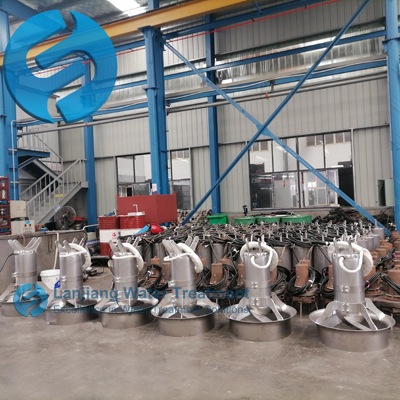The sewage mixer plays an important role in the sewage treatment process, but there may be some common faults during its use. Here are some common sewage mixer failures and their possible causes and solutions:
First, the device cannot be started
Possible causes:
1. Power failure: Check whether the power supply is normal and the cable is properly connected.
2. Motor failure: the motor may be damaged or triggered by overload protection. Check the motor for overheating and replace the motor or repair it if necessary.
3. Control device failure: The control switch, relay or contactor may have problems. Check that the controls are connected in place and that the joints are intact.
The solution:
1. Ensure that the power supply is normal and repair or replace the damaged cable.
2. Check and repair the motor fault or replace the motor.
3. Repair or replace the faulty parts in the control device.

Second, vibration or sway
Possible causes:
1. The submersion depth is not enough: the blender is not fully submerged in the water, forming a vortex and inhaling air.
2. Small pool capacity: mixing is too violent, resulting in unbalanced impeller.
3. The guide rod support installation foundation is loose: the support structure is unstable, resulting in vibration.
4. Multiple devices interfere with each other: multiple agitators may interfere with each other when working in the same pool.
5. Impeller damage: The impeller is worn or damaged, resulting in imbalance.
The solution:
1. Increase the submerged depth of the blender, making sure it is fully submerged.
2. Choose the equipment suitable for the pool volume to avoid excessive mixing.
3. Strengthen the guide rod to support the installation foundation.
4. Increase equipment spacing or set anti-interference board to reduce mutual interference.
5. Replace the damaged impeller and keep it balanced.
Third, the load current is too large
Possible causes:
1. Strong liquid viscosity or high concentration: increase the working load of the mixer.
2. Wrong direction of rotation: The mixer may rotate in the wrong direction, resulting in reduced efficiency and increased load.
3. Impeller blockage: there may be debris or sludge attached to the impeller, increasing the resistance.
4. Interference between the guide hood and the impeller: the gap between the guide hood and the impeller is too small, resulting in increased friction.
The solution:
1. Choose more high-power equipment or adjust process parameters to reduce liquid viscosity and concentration.
2. Check and adjust the rotation direction of the mixer to ensure that it is correct.
3. Remove debris and sludge from the impeller and keep it clean.
4. Adjust the gap between the guide hood and the impeller to reduce friction.
Fourth, abnormal noise
Possible causes:
1. Guide hood and impeller interference: the same load current is too large in the cause.
2. Bearing damage: bearing wear or damage leads to increased friction and abnormal sound.
The solution:
1. Adjust the gap between the guide hood and the impeller to reduce friction.
2. Replace the damaged bearing and keep the equipment in normal operation.
Fifth, other failures
In addition to the above common faults, the sewage mixer may also have problems such as stator overtemperature alarm, oil chamber leak alarm and so on. These problems are usually related to electrical systems, mechanical seals, or lubricants. Solutions include checking the electrical system, replacing the overtemperature alarm device, checking the performance of the mechanical seal, and regularly changing the lubricating oil.
In summary, the common faults of sewage mixers involve many aspects, and need to be investigated and solved according to the specific situation. During use, the equipment should be regularly checked and maintained to ensure its normal operation and extend its service life.
Post time:2024-09-09